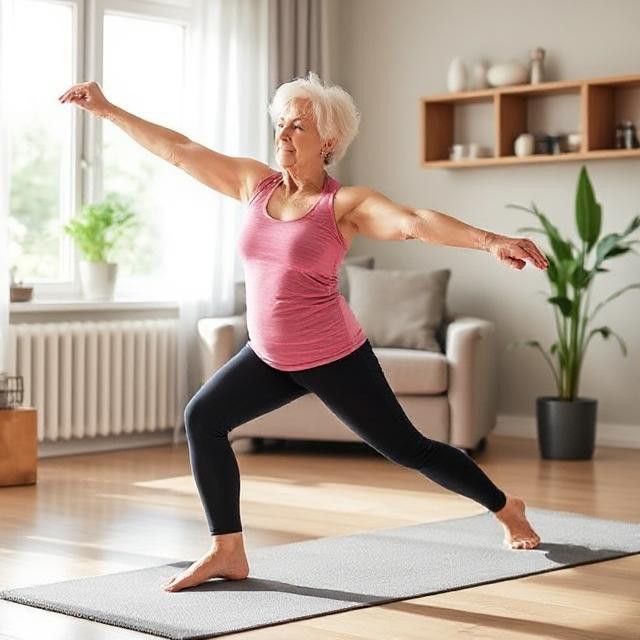As we age, maintaining a healthy weight becomes more challenging due to changes in metabolism, muscle mass, and activity levels. For those over 60, heading to the gym may not always be appealing or practical. Fortunately, you don’t need to rely on gym workouts to lose weight effectively. With smart adjustments to your daily routine, diet, and habits, you can achieve significant results right at home or within your existing lifestyle. Below are 7 effective, gym-free weight loss tips specifically tailored for those over 60, designed to be safe, sustainable, and empowering.
1. Prioritize Protein-Rich Meals
Eating enough protein is essential as we age, especially when aiming to lose weight without compromising muscle mass. Protein helps keep you fuller for longer, which can reduce unnecessary snacking and overeating. For people over 60, protein also supports the maintenance of lean muscle, which naturally declines with age. Include a high-quality protein source at every meal—think eggs for breakfast, grilled chicken or lentils at lunch, and fish or tofu for dinner. Don’t forget dairy like Greek yogurt or cottage cheese as convenient snacks. Protein also supports healthy bones, another concern in later life. The key is to space out your intake throughout the day rather than overloading at one meal. Balanced protein consumption helps regulate blood sugar levels and can subtly boost metabolism. You don’t need protein shakes unless advised by a healthcare provider; real food sources work just as well. Try incorporating variety so you don’t get bored—switch between beans, nuts, lean meats, and legumes. This simple adjustment can lead to noticeable changes in how you feel and how your body responds to your weight loss efforts.

2. Walk With Purpose Every Day
Walking is one of the safest and most effective forms of exercise for people over 60. It’s gentle on the joints, requires no special equipment, and can be easily built into your daily routine. Aim for at least 30 minutes of purposeful walking each day. This doesn’t mean a slow shuffle around the house; try to walk briskly enough that your heart rate increases slightly and you feel a bit warm. Walking helps burn calories, improve cardiovascular health, and boost mental well-being. It’s also a fantastic way to get some fresh air and Vitamin D if done outside. Consider breaking it into smaller chunks—three 10-minute walks throughout the day work just as well as one long session. Adding variety, such as walking in nature trails, parks, or even grocery store aisles, keeps it interesting. Invite a friend or join a walking group for accountability and social benefits. Over time, walking not only supports weight loss but also enhances balance, reduces the risk of falls, and improves sleep quality. It’s a deceptively powerful habit that’s sustainable, enjoyable, and incredibly rewarding.

3. Cut Back on Sugar and Refined Carbs
Refined sugars and carbohydrates—like white bread, pastries, soda, and many packaged snacks—are among the biggest culprits in age-related weight gain. They provide quick energy spikes followed by crashes that can leave you feeling hungry and sluggish. For individuals over 60, reducing these foods not only aids weight loss but also supports stable energy and lowers the risk of chronic conditions like type 2 diabetes and heart disease. Swap sugary snacks for whole fruit, and choose complex carbs like oats, quinoa, brown rice, or sweet potatoes. These foods digest more slowly, keeping you fuller longer and reducing cravings. Read food labels closely—many “healthy” foods contain hidden sugars. Start your day with a low-sugar breakfast like scrambled eggs or plain yogurt with berries to set a better tone for the day. It’s not about eliminating all carbs, but choosing smarter ones that support your long-term health and weight goals. Even modest reductions in sugar can lead to significant improvements in energy, focus, and fat loss. The less you eat sugar, the less your body craves it—making this change easier over time.

4. Stay Hydrated the Right Way
Proper hydration is often overlooked in weight loss discussions, yet it’s especially vital for people over 60. As we age, our sense of thirst diminishes, meaning you might be dehydrated without even realizing it. This can lead to fatigue, headaches, and even confusion—all of which affect your daily functioning and motivation. More importantly, dehydration is often mistaken for hunger, prompting unnecessary snacking. Aim to drink around 6–8 cups of water daily, depending on your body size and activity level. Herbal teas, broths, and water-rich fruits like watermelon and cucumbers also count. Try starting your day with a glass of water and sipping regularly throughout the day. If plain water feels dull, add slices of citrus or mint for natural flavor. Avoid sugary drinks like soda and limit fruit juices, which are high in calories. Staying well-hydrated supports digestion, improves skin elasticity, and helps the body metabolize fat more efficiently. Making water your beverage of choice can be a quiet but powerful weapon in your weight loss journey, especially when paired with mindful eating.

5. Practice Mindful Eating
Mindful eating involves paying full attention to your meals—savoring flavors, noticing hunger and fullness cues, and eliminating distractions. It’s especially valuable for people over 60 who may have developed lifelong eating patterns based more on routine than real hunger. Instead of eating in front of the TV or while multitasking, try sitting at the table and enjoying each bite. This simple shift helps prevent overeating and encourages better digestion. Slowing down your eating pace allows your body to register fullness more accurately, which can prevent those second helpings. Mindful eating also helps you recognize emotional eating triggers like stress, boredom, or sadness—common causes of weight gain. Keep a food journal to increase awareness of what and why you eat. You don’t need to count every calorie; the goal is to develop a more conscious relationship with food. When you eat with intention and gratitude, your meals become more satisfying, and you’re less likely to crave unhealthy snacks afterward. Over time, this practice can transform your eating habits and create a foundation for lasting weight loss success.

6. Get Consistent, Quality Sleep
Sleep is a critical yet underestimated part of weight management, especially for those over 60. Poor sleep disrupts the hormones that regulate hunger and metabolism, leading to increased cravings for sugary or fatty foods. It also makes you more tired, which can sap your motivation to move or eat well. Aim for 7–9 hours of sleep each night. Set a regular sleep-wake schedule, even on weekends, to help your body establish a consistent rhythm. Create a calming bedtime routine—limit screen time, lower the lights, and try gentle stretches or reading to wind down. Avoid large meals, caffeine, or alcohol too close to bedtime. If you struggle with sleep, speak to a healthcare provider—there are safe treatments and adjustments that can help. Better sleep improves energy, mood, and cognitive function, all of which support better decision-making around food and activity. It’s not just about how many hours you spend in bed, but the quality of rest you get. Good sleep helps your body recover, regulate, and burn fat more efficiently—making it a foundational pillar of healthy aging and weight loss.

7. Use Light Resistance and Stretching at Home
Strength doesn’t have to come from heavy weights or machines at the gym. Light resistance exercises using body weight, resistance bands, or household items can help maintain and build muscle, which is crucial for burning fat and staying mobile in your 60s and beyond. Aim for two or three sessions a week focusing on major muscle groups—think squats using a chair, wall push-ups, or bicep curls with soup cans. Include stretching routines to improve flexibility and reduce the risk of injury. Gentle yoga or tai chi can be highly beneficial and relaxing. Muscle naturally declines with age, but resistance training helps preserve it, boosting your metabolism and improving balance. It also supports bone health and joint stability. You don’t need to spend hours exercising—a 20-minute home session can deliver significant benefits. Consistency is more important than intensity. As your strength improves, you’ll notice better posture, increased energy, and even reduced pain or stiffness. Starting small and progressing gradually ensures that your routine is sustainable and enjoyable, keeping you on track toward your weight loss goals without ever needing to step into a gym.

Losing weight after 60 without the gym is not only possible—it can be practical, empowering, and even enjoyable. These tips prioritize what your body truly needs at this stage in life: nourishment, movement, rest, and awareness. By integrating simple yet impactful changes into your everyday routine, you can shed excess weight while also improving your health, energy, and outlook. The best part? These habits are sustainable, meaning your results are more likely to last. You don’t need extreme workouts or trendy diets—just thoughtful, consistent choices that respect your body’s current rhythm. Start small, stay committed, and trust that meaningful transformation is well within your reach.


